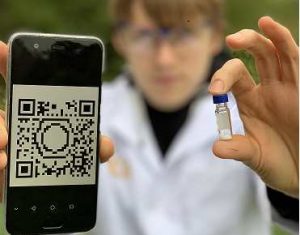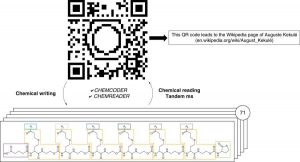R&D at Ghent University: USB Stick In Distant Future, Little Powder Should Suffice
Researchers developed chemical process that allowed information, such as piece of text or QR code, to be stored in powder form.
This is a Press Release edited by StorageNewsletter.com on November 6, 2018 at 2:28 pmFrom Ghent University
Whether you think about bank accounts, YouTube videos or QR codes, everything is saved as zeros and ones, or data, on a computer.

The storage equipment available might not be capable of holding all that information much longer. Ghent University successfully investigates alternative data storage methods
There are two major issues. On the one hand, enormous quantities of heavy metals are needed to produce USB sticks or hard drives. On the other hand, you need huge, energy-consuming servers to keep all this information safe.
For that reason, scientists from Ghent University’s chemistry, biochemistry and computer science departments have joined forces to look for new ways of storing data. In this research effort, they were inspired by nature, where genetic information is stored in DNA.
Chemical QR code
The researchers developed a chemical process that allowed information, such as a piece of text or a QR code, to be stored in powder form. This information can then be read out by means of a biochemical method of analysis. As a final step, two programs were written to make the processing of information run fast and automatically. The first program makes sure that the data on the molecules can be analysed in seconds, the second program automatizes the translation process from the QR code to the molecules and vice versa. That’s how the information stored in the molecules can in fact link directly to a website, a city map or an app.
The results of this interdisciplinary effort have been published in the high impact journal Nature Communications.
This project is remarkable in the sense that an important share of it was carried out by chemistry student Annelies Landuyt as part of the Honours Award in Science program set up by Ghent University’s faculty of Sciences. This program encourages excellent students to carry out interdisciplinary research alongside their regular curriculum.
Article: Multifunctional sequence-defined macromolecules for chemical data storage
Nature Communications has published an article written by Steven Martens, Annelies Landuyt, Pieter Espeel, Department of Organic and Macromolecular Chemistry, Polymer Chemistry Research Group, Centre of Macromolecular Chemistry (CMaC), Ghent University, Krijgslaan 281 S4bis, 9000, Ghent, Belgium,Bart Devreese, Department of Biochemistry and Microbiology, Laboratory for Protein Biochemistry and Biomolecular Engineering, Ghent University, K.L. Ledeganckstraat 35, 9000, Ghent, Belgium, Peter Dawyndt, Department of Applied Mathematics, Computer Science and Statistics, Ghent University, Krijgslaan 281 S9, 9000, Ghent, Belgium, and Filip Du Prez, Department of Organic and Macromolecular Chemistry, Polymer Chemistry Research Group, Centre of Macromolecular Chemistry (CMaC), Ghent University, Krijgslaan 281 S4bis, 9000, Ghent, Belgium.
Schematic representation of the QR code conversion. A QR code including a benzene structure, encoding the URL of the Wikipedia page of August Kekulé, who was the first to understand the structure of benzene and made a proposal for its structure, is translated to and written on 71 different sequences. Translation is done using the Chemcoder algorithm. The sequences are read afterwards by means of tandem MS and the Chemreader algorithm. Given these sequences, Chemcoder is able to reconstruct the original QR code. Different building blocks in the sequence are highlighted: start fragment (purple box); backbone (yellow boxes), stop fragment (green box) and the functionalities (grey and blue boxes)
Click to enlarge
Abstract: “Sequence-defined macromolecules consist of a defined chain length (single mass), end-groups, composition and topology and prove promising in application fields such as anti-counterfeiting, biological mimicking and data storage. Here we show the potential use of multifunctional sequence-defined macromolecules as a storage medium. As a proof-of-principle, we describe how short text fragments (human-readable data) and QR codes (machine-readable data) are encoded as a collection of oligomers and how the original data can be reconstructed. The amide-urethane containing oligomers are generated using an automated protecting-group free, two-step iterative protocol based on thiolactone chemistry. Tandem mass spectrometry techniques have been explored to provide detailed analysis of the oligomer sequences. We have developed the generic software tools Chemcoder for encoding/decoding binary data as a collection of multifunctional macromolecules and Chemreader for reconstructing oligomer sequences from mass spectra to automate the process of chemical writing and reading.“













 Subscribe to our free daily newsletter
Subscribe to our free daily newsletter
